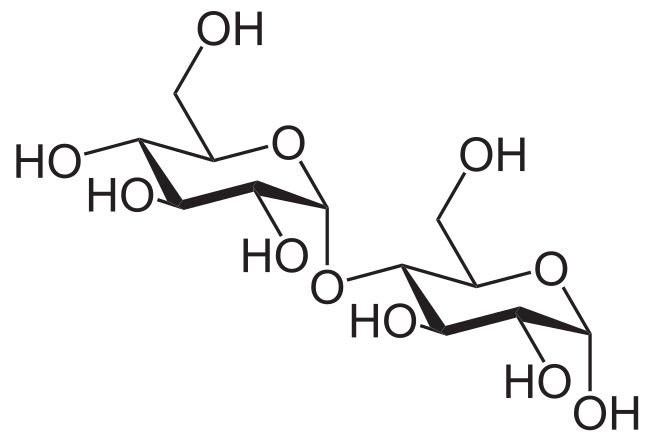
Main Difference
The main difference between Maltose and Dextrin is that the Maltose is a chemical compound, sugar that exists in wheat and Dextrin is a group of low-molecular-weight carbohydrates produced by the hydrolysis of starch or glycogen.
-
Maltose
Maltose ( or ), also known as maltobiose or malt sugar, is a disaccharide formed from two units of glucose joined with an α(1→4) bond. In the isomer isomaltose, the two glucose molecules are joined with an α(1→6) bond. Maltose is the two-unit member of the amylose homologous series, the key structural motif of starch. When beta-amylase breaks down starch, it removes two glucose units at a time, producing maltose. An example of this reaction is found in germinating seeds, which is why it was named after malt. Unlike sucrose, it is a reducing sugar.
-
Dextrin
Dextrins are a group of low-molecular-weight carbohydrates produced by the hydrolysis of starch or glycogen. Dextrins are mixtures of polymers of D-glucose units linked by α-(1→4) or α-(1→6) glycosidic bonds.
Dextrins can be produced from starch using enzymes like amylases, as during digestion in the human body and during malting and mashing, or by applying dry heat under acidic conditions (pyrolysis or roasting). This procedure was first discovered in 1811 by Edme-Jean Baptiste Bouillon-Lagrange. The latter process is used industrially, and also occurs on the surface of bread during the baking process, contributing to flavor, color and crispness. Dextrins produced by heat are also known as pyrodextrins. The starch hydrolyses during roasting under acidic conditions, and short-chained starch parts partially rebranch with α-(1,6) bonds to the degraded starch molecule. See also Maillard Reaction.
Dextrins are white, yellow, or brown powder that are partially or fully water-soluble, yielding optically active solutions of low viscosity. Most of them can be detected with iodine solution, giving a red coloration; one distinguishes erythrodextrin (dextrin that colours red) and achrodextrin (giving no colour).
White and yellow dextrins from starch roasted with little or no acid are called British gum.
-
Maltose (noun)
A disaccharide, C12H22O11 formed from the digestion of starch by amylase; is converted to glucose by maltase; it is an isomer of trehalose
-
Dextrin (noun)
Any of a range of oligomers of glucose, intermediate in complexity between maltose and starch, produced by the enzymatic hydrolysis of starch; used commercially as adhesives.
-
Maltose (noun)
a sugar produced by the breakdown of starch, e.g. by enzymes found in malt and saliva. It is a disaccharide consisting of two linked glucose units.
-
Dextrin (noun)
a soluble gummy substance obtained by hydrolysis of starch, used as a thickening agent and in adhesives and dietary supplements.
